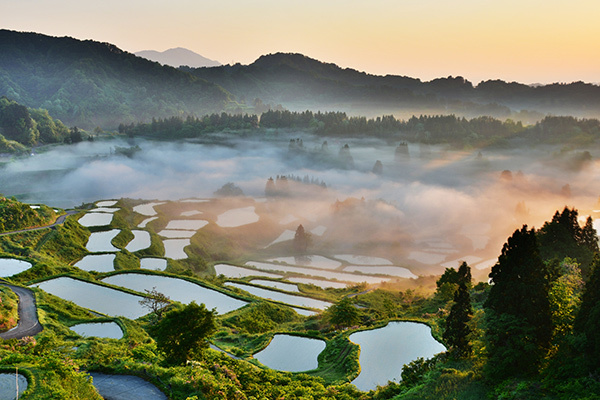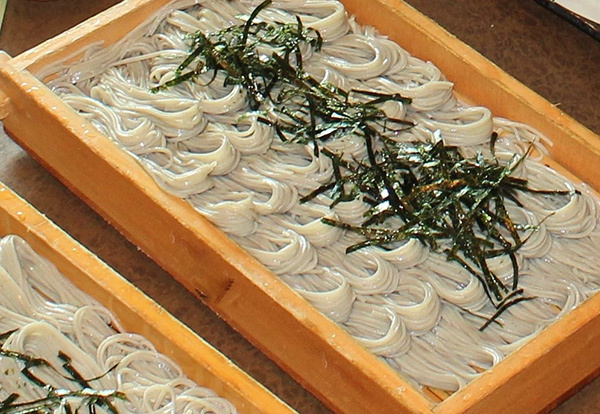Tokamachi; A city alive with art and spectacular views
Tokamachi is located in the southern part of Niigata prefecture.
The area is known for its heavy snowfall and rice production, but it has many other sides to it, too.
For example, once every three years, they hold the Echigo-Tsumari Art Triennale, an “art festival of the earth”.
(Hachi & Seizo Tashima Museum of Picture Book Art)
More than 200 works of art are placed around the local landscape, and during a 50-day period,
they attract more than half a million people from all over the world who come to enjoy this collaboration between nature and art.
(The last classroom)
There are also the Hoshitoge Rice terraces, which display beautiful landscapes in every season.
Around 200 paddy fields spread out along the mountain slopes, creating a breathtaking view.
Once you arrive in Tokamachi, a city filled with such art and beautiful landscapes,
there’s one dish that you’ll definitely want to try.
Hegi-soba is a local specialty of Uonuma, Niigata,
and one particular restaurant famous for this dish is Soba no Sato Abuzaka.
(Kiyotsu Gorge Tunnel)
What is “hegi-soba”?
"Hegi" is a local accent of the word "Hagu" in Niigata.
And “Hagu” means to strip or peel.
This is pronounced as “hegu” in some dialects, and so “hegi” refers to a serving dish made from planed wood.
Here you can see the “hegi-soba” placed inside the “hegi”.
To make this dish, freshly boiled soba noodles are rinsed under cold water.
Easy to eat, bite-sized amounts are then laid out on the dish in a rounded pattern.
The noodles are folded in half by hand using a technique known as “taguri”.
They are then placed inside the “hegi”, hence the name “hegi-soba”.
One large dish serves 3 or 4 people, and it’s often enjoyed among large groups at festivals or on ceremonial occasions.
The secret to what makes hegi-soba delicious
What makes hegi-soba so appealing is its firm texture and the way it just slips down so easily.
Normal soba noodles have a slightly rougher texture, but hegi-soba is completely smooth.
When people first try it, they get a bit of a surprise and wonder if it’s really soba.
The reason behind this is the extra ingredient these noodles contain.
For a long time now, the city of Tokamachi has flourished in the textile industry.
When weaving fabrics, they use a type of seaweed called “funori” to starch the yarn and make it stiff.
Eventually, funori was also used to make soba noodles, creating the unique, slippery texture of hegi-soba.
There’s one restaurant where you can enjoy this unique hegi-soba dish with extra special service.
Soba no Sato Abuzaka: A well-known store recommended by locals
About 10-minutes by car from Tokamachi Station,
the modern and stylish Soba no Sato Abuzaka restaurant appears from the middle of nowhere surrounded by countryside.
It was built in an area called Abuzaka, and wanting others to enjoy the local ingredients,
it was given a name filled with love towards Abuzaka.
Inside, there are around 50 seats and high ceilings, with a modern Japanese atmosphere.
From the windows, you get a panoramic view of the stunning Abuzaka landscape.
Anyone who visits should definitely try the Buffet Lunch,
which costs 1,520 yen for adults and 500 yen for elementary school children (tax not included).
Free for preschoolers who don’t order soba or udon.)
The buffet includes either soba noodles or udon noodles which are made from rice flour,
and side dishes made from wild plants and vegetables.
That’s a rather reasonable price, wouldn’t you say?
You’re probably intrigued by this buffet, but let’s first take a look at their prized dish, the hegi-soba.
At Abuzaka, they grow their own soba from a variety native to Niigata which has a strong aroma and excellent taste.
This is then carefully ground into flour using a millstone.
Using trial and error, they worked out what ratio of funori seaweed and water produces the best taste and texture.
Here is Abuzaka’s specialty hegi-soba, freshly cooked.
It’s truly a masterpiece, with its rich aroma and smooth, slippery texture.
The buffet is amazing, too.
The counter is full of local, freshly picked wild vegetables and homemade vegetable side dishes.
It’s all-you-can-eat, so make sure to enjoy—everything except the soba is served buffet-style!
Making the most of seasonal ingredients,
plenty of country cooking is served up and arranged in a way that’s easy for younger people to eat, too.
Around 12 or 13 kinds of colorful dishes are all lined up, including sesame miso kogomi (ostrich fern fiddleheads),
Japanese-style rolled omelette, vegetables cooked in a dashi broth, and a vegetable miso soup.
It’s a lot of fun just having a look and deciding what to eat!
The freshly fried tempura with green tea salt is also the best.
And of course, the dessert is homemade, too.
There’s also a stylish looking souvenir corner next to the cash register.
They have ready prepared side dishes and local seasonal ingredients on sale,
and you’ll probably end up wanting to take some home with you.
They have tableware and chairs for children, and changing tables and a seating area, too.
You can tell the restaurant is very considerate towards those with children.
The menu also is available in English and Chinese (Simplified & Traditional).
The shop is only open for business during their “Lunch Time” and “Café Time” hours.
(As of June 2020, they only offer their Lunch Time services.)
On weekdays, 11:00 or 13:00 are the best times to avoid the crowds.
On Saturdays, Sundays and public holidays, the restaurant is often full but it’s possible to make a reservation,
so make sure to phone up and reserve your table beforehand.
But note that even if you make a reservation, there may still be a short wait after you arrive.
With a satisfaction rate of 200%,
this is a restaurant where you can fully enjoy the taste of Tokamachi while admiring the magnificent views.
Please try the unique masterpiece that is “hegi-soba”.
(Writter Yukiko)
 JAPAN Travel Concierge
JAPAN Travel Concierge














